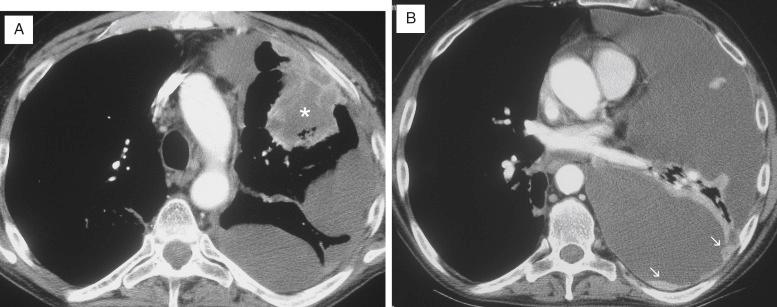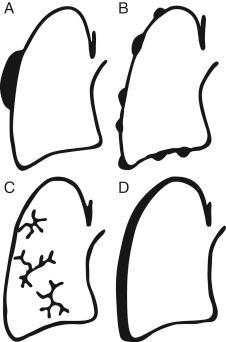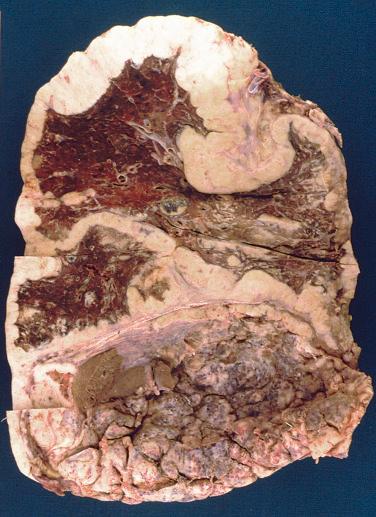Physical Address
304 North Cardinal St.
Dorchester Center, MA 02124
Over 150,000 malignant pleural effusions occur each year in the United States, the majority of which result from pleural involvement by extrapleural malignancies. Although pleural involvement generally occurs at an advanced stage of disease, in some cases symptoms related to pleural involvement are the presenting manifestation of the neoplastic process. Occasionally, it is difficult to determine the site of origin of pleural metastases; in as many as 10% of malignant pleural effusions, no primary site is found. Metastases can grow along the pleura in a “pseudomesotheliomatous” fashion, simulating the appearance of malignant mesothelioma.
Extrapleural malignancies can gain access to the pleural space from pleural lymphatics that connect with mediastinal and transdiaphragmatic chest wall lymphatics. Other mechanisms by which tumors involve the pleura include direct extension from an adjacent site, such as the lung, or through hematogenous spread. Tumors that metastasize to the pleura by lymphohematogenous dissemination have a tendency to involve the inferior aspects of the pleura, which are the most dependent regions of the pleura, often bilaterally.
Although pleural involvement has been described for neoplasms originating in nearly every anatomic site, the most common extrapleural neoplasm to involve the pleura is lung carcinoma. Breast carcinoma is second in frequency, which in large part accounts for the 1.5 to 2 times higher incidence of malignant pleural effusions in women.
This chapter focuses on the most common extrapleural neoplasms to involve the pleura and reviews the features that distinguish these neoplasms from malignant pleural mesothelioma. The most common presenting symptom of pleural involvement by extrapleural neoplasms is dyspnea secondary to the pleural effusion. However, an identical presentation may also occur with malignant mesothelioma. Pathologic evaluation is necessary to distinguish between these entities.
Accounts for about 60,000 malignant pleural effusions each year in the United States, which is approximately 40 times the number of malignant pleural effusions related to malignant mesothelioma
Dyspnea secondary to pleural effusion is the predominant symptom
Pleural effusion
Multiple small nodules, irregular thickening by larger nodules, or rarely, diffuse thickening of the pleura
Intrapulmonary component usually evident but may be difficult to detect in some cases
Signifies advanced stage of disease
Only 15% of lung cancer patients survive more than 6 months after development of malignant pleural effusion
White-to-tan, firm pleural nodules or masses
Occasionally, in cases of lymphangitic spread, finely reticulated pattern over the pleural surfaces
Uncommonly, white-to-tan, rindlike, diffuse pleural thickening with encasement of the underlying lung (“pseudomesotheliomatous” growth pattern)
Morphology usually similar to primary tumor
Array of patterns in adenocarcinoma, including acinar, glandular, tubulopapillary, micropapillary, and solid patterns
Intracytoplasmic mucin vacuoles in some adenocarcinomas
Adenocarcinoma cells often have eccentric nuclei, prominent nucleoli, and greater pleomorphism than cells of malignant mesothelioma
Desmoplastic stroma is common
Cells have high nuclear-to-cytoplasmic ratio, irregular nuclear contours, and one or more nucleoli
Cells arranged in sheets, acini, papillary formations, or three-dimensional clusters
Three-dimensional clusters usually have smooth community borders
In mucin-producing tumors, intracytoplasmic vacuoles are positive for PAS and alcian blue; staining is not abolished by pretreatment with diastase (PAS-D) or hyaluronidase, respectively
Adenocarcinomas of the lung generally stain with some of the following antibodies: TTF-1, napsin A, MOC-31, BG-8, CEA, LeuM1(CD15), and Ber-EP4
Squamous cell carcinoma of the lung is negative for TTF-1 and positive for p63, p40, and CK5/6; however, CK5/6 also stains a high percentage of pleural mesotheliomas
Adenocarcinomas usually demonstrate short microvilli, may contain secretory granules, and may show terminal bars adjacent to glandular lumens
Malignant mesothelioma
Metastatic carcinoma of nonpulmonary origin
Reactive mesothelial hyperplasia
Lung carcinoma is the most frequent cause of malignant pleural effusions in the United States. Between 7% and 15% of all lung carcinomas are accompanied by malignant pleural effusions. Although malignant pleural effusions are observed with all histologic types of lung carcinoma, they are most commonly associated with adenocarcinoma. The frequency of malignant pleural effusion in adenocarcinoma relative to other histologic types is almost certainly related to the propensity for adenocarcinoma to arise in the periphery of the lung, where it can directly invade the visceral pleura.
Lung carcinoma should be strongly suspected if dyspnea is accompanied by hemoptysis.
Lung carcinoma involving the pleura often manifests radiographically as a pleural effusion. An intrapulmonary site of origin is radiographically evident in most cases but is sometimes difficult to discern. Occasionally, an effusion may be so voluminous as to obscure a pulmonary mass, requiring drainage to facilitate detection. Direct extension into the pleura may produce a discrete pleuropulmonary mass. Alternatively, the pleura can be studded by multiple small nodules or become irregularly thickened by larger nodules ( Fig. 33.1 ). In rare cases, the pleura appears diffusely thickened. This pattern can mimic malignant mesothelioma, particularly in cases where an intrapulmonary component is not radiographically apparent.

Malignant pleural effusions from lung carcinomas are typically exudative and appear somewhat cloudy. Occasionally, they are grossly bloody. Depending on the extent of involvement, lung carcinomas that directly invade the pleura may produce puckering and slight granularity of the visceral pleura surface. In more advanced cases, they can form a white-to-tan, firm nodular pleural mass ( Fig. 33.2A ). Pulmonary carcinomas that metastasize to the pleura through lymphohematogenous dissemination may give rise to multiple firm, white-to-tan nodules of variable size ( Fig. 33.2B ). Rarely, metastatic tumor diffusely plugs pleural lymphatic channels, forming a finely reticulated pattern over the pleural surfaces without generating a pleural mass or nodule ( Fig. 33.2C ). An uncommon pattern of pleural involvement, so-called pseudomesotheliomatous carcinoma, can cause considerable confusion with malignant mesothelioma. Pseudomesotheliomatous carcinomas are characterized by firm, white-to-tan, rindlike diffuse pleural thickening that may encase the underlying lung ( Figs. 33.2D and 33.3 ). In some cases of pseudomesotheliomatous carcinoma, an intrapulmonary source may not be grossly evident, making the diagnosis more challenging.


Become a Clinical Tree membership for Full access and enjoy Unlimited articles
If you are a member. Log in here